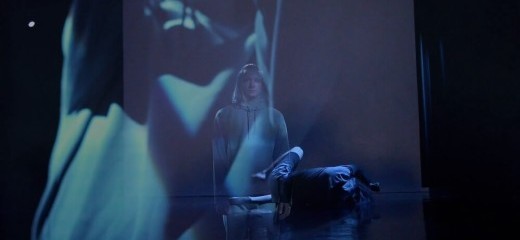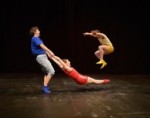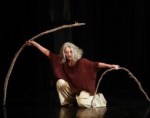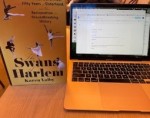
A Study in Setting
by Ellen Miller
There was a time, not that long ago, when video was an essential dance medium. It was both strange and familiar to find myself back in a Zoom. I logged on to Leah Stein Dance Company’s FILM WORKS presentations- One of three separate events highlighting different artists, allowing for multiple opportunities for engagement, both in Philadelphia and virtually. The works were curated in collaboration with Keila Cordova. They included “films and videos by (mostly) local, dance/performance artists experimenting with movement, sound and the body.”*
The program kicked off with | community | by loren mcfalls.** Ominous music plays as photographs of eight dancers, leah behm, shea carponter-broderick, danni clark, meg gourley, t’shauna henry, jenna latham, emma morris, and ryan plecha, are laid atop one another. The collection of photos slowly blends into a video of the same dancers circling each other, leaves underneath their feet. mcfalls’ work, committed to exploring the idea of connection, was filmed in their backyard. This setting - a showcase on Zoom - influences my interpretation. Though filmed in 2023, it calls back to when the concept of connection was only possible from a distance or outdoors. It still reflects how we portrayed community during the height of the pandemic. Were the film to be screened in-person, it might be interpreted very differently.
Christy Walsh’s Cistern; After Murakami opens with the dancer (Walsh) in a cistern, and alludes to Murakami’s “surrealistic use of empty wells as a conduit between multiple realities.” We hear clinking sounds, like a pipe being hit with a piece of metal, or like the sound of dripping water. Walsh, dressed in a shiny purple leotard, moves in a circular pattern around the sand floor in a small, square stone room. She uses the wall as a barre and the column in the middle of the space as a partner, wrapping her leg around it as she moves from front to back attitude. She ends up sitting on the floor with her legs extended as the screen fades to black. When the image fades back in, she is lying on her back on the rocks of a beach. She rises to pose, goddess-like, staring into the ocean as she holds an arabesque. Later, she snaps her fingers rhythmically. This recalls the clinking music from the cistern – plink, plink, plink/ snap, snap, snap- an acoustic tie between two parts of the dancer’s journey.
For Cognatus, Britt Fishel and Artists also filmed outdoors. Five dancers, Teigha Beth Bailey, Elizabeth Cousar, Noëlle Davé, Lexi DiFilippo, and Lydia Patselas, lie on the grass dressed in earth tones and white sneakers. The softness in the colors, filtering, and focus in the film, combined with the piano music, bring to mind a modern Austen adaptation. The filming centers closeups, creating snapshots: a snake tattoo around an arm, a nose ring, a scooping motion as a dancer’s arms circle widely. Hand over their heart, a solo dancer crouches while two pairs of dancers embrace back-to-front behind them. A dancer walks backward into a previously unseen pond, submerging themself, floating.
By contrast, Amber Hongsermeier’s Penumbra was filmed in a black-box theater, allowing Hongsermeier*** and her dancer, Nova Teeling, to play with shadow and light. Teeling falls back and to the side over and over, catching herself softly with her hands before standing again. Given the venue, the work feels more like “filmed dance” than “dance film.” Hongsermeier utilized Teeling’s birth chart and a weekly tarot draw in developing the choreography. Hongsermeier was also informed by diving into shadow work, and processing the things in the (shadow) self that we are taught to dislike. The result of this research is visible in the projections on the wall, the shadows created by the dancer as she jumps and falls throughout the space, and different cuts of the dancer herself, a body in motion in different timing. This use of layering tells the story of grief and loss.
Oona Taper’s The Sound of Sinking Ships closed the show. The film starts with scratchy black-and-white images intermingling with an animated shifting and moving graphic outline. Taper physically manipulated 7 mm and 8 mm film and created an animation to explore how far they could deconstruct the figure to become only movement, without losing the dance entirely. Taper utilized bleach and sandpaper to physically alter the film, resulting in a highly abstract creation that walks the line between animated film and dance film.
In Cistern; After Murakami, while the movement is strong, ultimately the most memorable part is the reservoir and the ocean; similarly, Fishel and mcfalls’ use of outdoor space creates vivid metaphors. By contrast, Hongsermeier’s work evokes a very different feeling of place, and Taper’s piece deconstructs the idea of a setting entirely. Often with dance, I leave reflecting on the choreography, the costumes, or the overall tone of the performance. In FILM WORKS, the most defining characteristic was the decisions of the choreographers and filmmakers regarding where and how to film the work.
*All quotes taken from the FILM WORKS program are available here.
**All dancers in the piece | community | were credited with their names in lowercase.
**The author, Ellen Miller, has previously danced in a work choreographed by Hongsermeier.
FILM WORKS, Various Artists/ Leah Stein Dance Company, Zoom, May 11, 2024
By Ellen Miller
June 2, 2024









